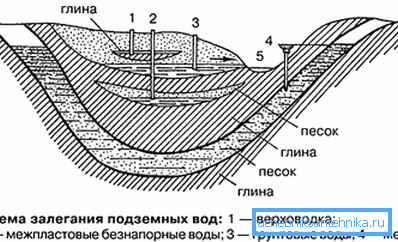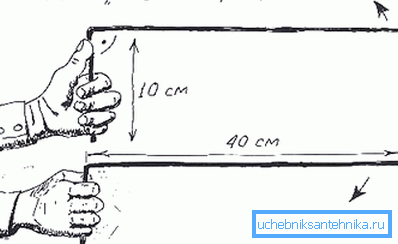How to find a place for a well on the territory of a
Many people think that it’s impossible to build a structure for water extraction on the site, as it’s very difficult to know where the liquid is located closer to the surface without special devices. However, if you wish, you can use traditional methods that allow you to find a suitable source. At the same time, the choice of a place for a well should be combined with sanitary standards.

Basic requirements and rules
Thanks to the correct design of water intake facilities, it is possible to solve not only issues related to durability and reliability, but also to protect the source from pollution. To provide drinking water, aquifers should be used that are protected in the form of waterproof rocks.
On the choice of the site on the territory
Before proceeding to the search for deposits, it is necessary to become familiar with the main requirements for structures of this type.
First of all, you need to understand how to choose a place under the well, without violating sanitary standards.

- The site must be located at a distance of more than 20 meters from various sources of pollution. (sewer systems, compost pits, fertilizer depots, and so on).
- When choosing, it is necessary to take into account the location in relation to the residential building and other objects, so that later the source was convenient to use.. The best option - the location in the central part of the site.
- You cannot choose a place that is regularly flooded.. Structures should also not be located on wetlands, in areas with landslides and other types of deformations.
Addition! It is desirable to have such structures on high ground in order to be less concerned about the quality of water, which external factors can sometimes influence.
Ways of finding deposits
When an individual developer asks a question how to find a place for digging a well, he can take into account several options at once, which are given below. In this case, there is no need to invite specialists, due to which the price of the water intake system is markedly reduced. All search techniques can be divided into separate items.

Observation of natural phenomena
In many situations, nature can tell how to find a place under the well, especially if you closely monitor its manifestations.
In this situation, special studies are not used with the use of expensive equipment, so the total cost of the design does not increase.
- As a rule, at a place with close bedding of an aquifer, a little more dew falls out than in other zones, and this site is most often located in a valley and contains bumps and tubercles.
- Sometimes trees help to make a choice. Lonely oaks usually grow at the intersection of numerous fluid layers. If maple, willow, birch and alder lean in the same direction, then you can arrange a source nearby.
- Indicate the location of the aquifer capable of grass vegetation. A fairly thick undergrowth always wavers above it, and the summer drought has little effect on it.
- After sunset, swarms of mosquitoes and black flies circle mostly above the place where there is water underground. However, the presence of red ants suggests the opposite situation.
- An underground source is usually found where fog spreads low. The thicker it is - the closer the life-giving moisture. Above the surface of such areas a peculiar haze is formed.
- In some cases, the definition of a place for a well is carried out based on the behavior of domestic animals. For example, dogs try to dig small holes in wet areas during the heat.

Note! Thus, careful observation of nature will provide an opportunity to understand how to find a place - where to dig a well. Putting all the moments in a single composition, you can minimize errors.
Biolocation search
This method is considered the most reliable when it comes to finding the aquifer. As the main tool can be used a device consisting of two electrodes, or a well-dried vine. (See also the article Filter for a well: features.)
It is advisable to insert aluminum elements into special elderized tubes from the core.

- First, using the compass is determined by the four sides of the world, after which the pegs are set, corresponding to each of them. Vertical racks slightly driven into the ground.
- An electrode is taken into each hand, while the elbows are pressed directly to the sides. The forearms should be parallel to the ground so that the elements become an extension of the arms.
- Movement begins on the territory from north to south, and then from east to west. If you manage to stumble upon an underground source, the electrodes will cross. The place is marked with a peg.
- The water below is in the form of special layers, and therefore, having found one point, you need to go to search for the entire watercourse. To do this, the above operation is repeated several times.

Note! The above information helps to learn how to choose the right place for the well using biolocation. However, the disadvantage of the study is that the electrodes can react to the upper layers and underground communications.
Use of moisture absorbers
By weighing some substances and materials, you can find a source underground by calculating the difference in mass. The following is information about how to determine a place for a well using various moisture absorbers.
However, such tests should be performed on dry days.

- At the initial stage, one or more pots of unglazed clay are prepared, as well as any non-woven material with which you can wrap the container.
- Red brick (the simplest desiccant) is crushed into small pieces that fit in the prepared container. After that, small fragments are well dried.
- Shards of material are placed in clay pots and pre-weighed. Initial indicators after burrowing into the ground will increase markedly, so it will turn out to determine the appropriate option.
- To find out how to choose a place for a well, one should divide the territory into several separate zones, after which in each of them bury the containers to a depth of about 50 cm, wrapping them in special matter.
- After 24 hours, clay containers with a moisture absorber must be removed from the ground and reweighed. The more significant the difference in terms of mass - the closer the aquifer is.
Attention! When acquaintance with the information on how to correctly find a place for a well occurs, certain conditions must be taken into account. For example, actions are not carried out, if two days have not passed since the moment of precipitation.
Exploration with a drill
The most accurate method for finding the source of water is exploration drilling, which is performed by conventional garden tools. For this, a well is made with a depth of six meters. After finding the aquifer, it is possible to transfer the liquid to a sample in the laboratory. (See also the article Water Well Analysis: Features.)

As a conclusion
Above was given a guide that allows you to familiarize individual developers with how to determine a place under the well the most relevant to date ways. However, when searching, it is recommended to combine several of them at once in order to avoid mistakes. Additional information on this topic is presented in detail in the video in this article.